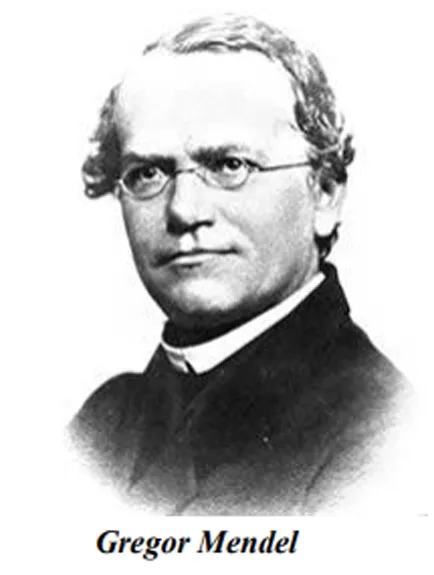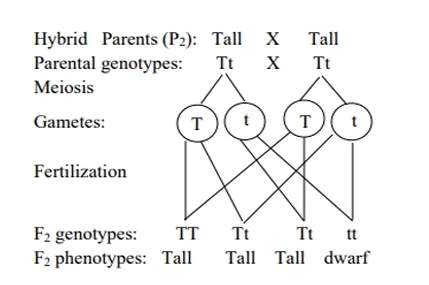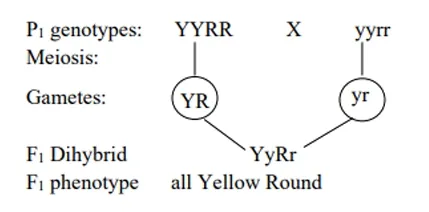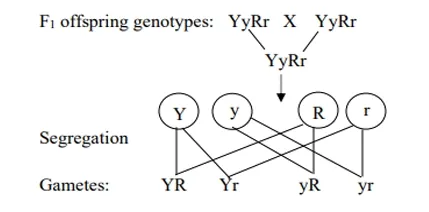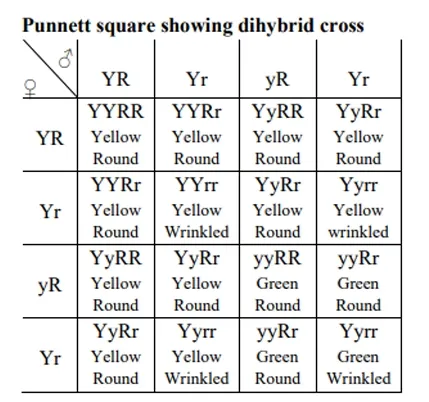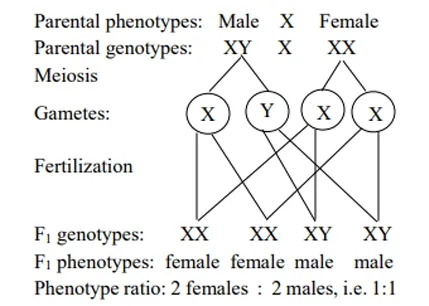Understanding Mendelian Inheritance: A Comprehensive Guide to Classical Genetics
Objectives
The reader will be able to:
o Explain the term genetics.
o Explain and define some terms used in genetics with examples.
o Explain the concept of inheritance.
o State and explain Mendel’s first and second laws of inheritance.
o Explain the terms linkage, sex determination, and sex-linked characters.
INTRODUCTION TO GENETICS
Genetics is the study and understanding of the phenomena of heredity and variation. It is a branch of biology concerned with the structure, transmission and expression of hereditary information.
o
Heredity: is the transmission of traits
or characters from one generation to the next, i.e., from parents to their
offspring.
Genetic Terminology
o Chromosome: is thread-like structures in the nucleus of a cell. It consists of chromatin and carry genetic information arranged in a linear sequence. It is comprised of a double stranded DNA molecule with associated histone proteins
o Chromosome Number: is the total number of chromosomes in a somatic cell. It is fixed for any particular species. E.g. Man has 46; garden pea has 14 etc.
o Homologous chromosome: is identical pair of chromosomes in the nucleus of a cell, having equal size and shape. One of each pair is inherited from each parent.
o Gene: is a unit of inheritance for a given character or trait and is located in the chromosome. Or is the basic functional unit of heredity that carries information from parent to offspring.
o Locus: is the site on a chromosome occupied by a gene.
o
Allele: An alternative form of a gene
that occurs at the same locus on homologous chromosomes e.g., A, B, and O genes
are alleles.
o Character or Trait: any detectable phenotypic property of an organism.
o Genome: is the total genetic material of an organism.
o Genotype: genetic constitution of an organism. Or the sum of all the alleles present in a genome.
o Phenotype: the external (morphological) appearance of an individual due to gene action or interaction with the environment e.g., skin color, body size, ability to roll the tongue, intelligence, blood group etc.
o Diploid: is when nucleus of an organism consists of a full set of genetic material (or two set of chromosomes). It represented by a symbol 2n. E.g., human has 46 chromosomes in somatic cells.
o Haploid: is when a nucleus of an organism consists of a single set of chromosomes. It represented by a symbol n. E.g., human has 23 chromosomes in sex cells
o Homozygous: the situation in which allelic genes are identical, e.g., KK or kk.
o Heterozygous: the situation in which allelic genes are different, e.g., Kk.
o Dominant: an allele is dominant if its effect can be observed in the phenotype of a heterozygote. That is an allele/gene/character which expressed in the appearance of organism (phenotype) even though there is the presence of alternate allele/gene/character.
o Recessive: allele/gene/trait is member of a pair of alleles that does not show its characteristic in the phenotype in the presence of any other allele. That is allele whose effect can only be seen when it is homozygous. e.g., hh genes.
o First Filial (F1) generation: the progeny or offspring produced from a cross between two homozygous parents (P1).
o Second Filial (F2) generation: progeny produced by crossing the F1 generations.
o Hybrid: offspring produced by crossing two different species (i.e., pure breeding).
o
Monohybrid
cross: the
cross between two parents differing in a single pair of contrasting characters.
o
Dihybrid
cross: the
cross between two parents in which two pairs of contrasting characters are
studied simultaneously for the inheritance pattern. The F1 offspring is described as dihybrid or double
heterozygous.
o
Albinism: is condition in human where there is failure to produce
skin pigments.
o Polygenetic inheritance: is the determination of a character controlled by many genes each having an effect on the phenotype. Such character shows continuous variation.
o Crossing over: The exchange of genetic material between members of a pair of homologous chromosomes.
o Mutation: is spontaneous change in a gene or chromosome of an organism.
o
Codon: A sequence of three
bases in DNA or RNA that code for a single amino acid. It enables specific
proteins to be made by specific genes
Mendelian Inheritance
Gregor Mendel (1822–1884) was an Austrian monk. He investigated nature of inheritance in pea plants (Pisum sativum) and published his results in 1866. They were ignored at the time, but were rediscovered in 1900, and Mendel is now recognized as the "Father of Genetics".
Mendel chose garden pea as plant material for his experiments, since it had the following advantages
Ø well defined characters,
Ø bisexual flowers,
Ø are capable of self-fertilization,
Ø easy hybridization
Mendel’s Experiments
Monohybrid Inheritance
Initially, Mendel concentrated only on the inheritance of a single
pair of contrasting characters. This type of inheritance is called monohybrid.
Mendel selected several varieties of garden pea plants with one pair of
contrasting characters or traits such as:
□
seed texture (round
& wrinkled)
□
seed color (green
& yellow)
□
flower color (white
& purple)
□ growth habit (tall & dwarf or short)
v In one experiment, Mendel crossed or cross-pollinated pure breeding tall pea plants with dwarf plants. He collected the seeds from this cross and allowed them to germinate. All the resulting plants (F1 generation) were found to be tall.
v Mendel then allowed the tall plants of the F1 generation to undergo self-pollination. In the next generation (F2 generation), these seeds gave rise to both tall plants and dwarf plants, approximately in the ratio 3:1. This is known as monohybrid ratio.
v When the experiment was repeated for other contrasting traits (seed
color; green verses yellow, seed texture; round verses wrinkled etc.), the
results were similar what was obtained for the tall and short.
Mendel’s Explanation
v Based on these results, Mendel came to the conclusion that in a cross-involving two contrasting characters, only one character expresses itself in the next generation.
v Mendel called the character, which expressed it effect as dominant
character and the character, which failed to express, as recessive
character. This idea came to be known as the principle of dominance.
v Mendel came to the conclusion that certain factors (now called genes
or alleles) are involved in the expression of each contrasting
characters. He presumed this plant should have contained two factors, one
responsible for tallness and the other responsible for dwarfness.
v He represented his ideas by using letters of English alphabet. He
represented the factor for dominant character by a capital letter and the
factor for recessive character by a small letter.
Step One
Factor for tallness = T
Factor for dwarfness = t
Parental genotype
Pure breeding tall plant = TT
Pure breeding short plant = tt
Step Two
(self-pollination of F1 Plants)
Genotypic ratio: 1TT : 2Tt :
1tt i.e. (1:2:1)
Phenotypic ratio: 3
Tall :
1 Dwarf
(i.e ratio 3 : 1; probability ¾ , ¼; percentage 75% , 25% )
v Based on these results. Mendel formulated a law, which is known as the Law of inheritance or law of segregation or the law of purity of gametes. The law states that inherited character or trait is controlled by a pair of genes and that each pair of the gene segregate (separate) during the formation of gametes.
According to Mendel, each sexually reproducing organism possesses two genes for each character; one gene is inherited from male parent and the other factor is inherited from the female parent. These two genes for a particular character are called alleles. When an offspring receives identical alleles from both parents, it is called homozygous (e.g TT). On the other hand, when the offspring receives dissimilar alleles from two parents, it is called heterozygous (e.g. Tt).
Test Cross or Back Cross
Test cross is a simple method devised by Mendel to verify the
genotype of the F1 hybrid. When the F1 hybrid is crossed
with the homozygous recessive parent, it is called a test cross. Thus, test
cross is used to determine whether and organism is heterozygote or a
homozygote. Since, the F1 is
crossed back with one of the parents, it is also called a back cross.
In test cross, if the phenotypically dominant individual is homozygous for the dominant character, all the offspring will show the dominant character. If the individual is heterozygous for the dominant character, a ratio 1:1 of the dominant and recessive character will be obtained.
First crossing
Parental phenotypes: Unknown Tall
X Homozygous Short
All the offspring are tall, therefore unknown is homozygous with
genotype TT
Second Cross
Parental phenotypes: Unknown Tall
X Homozygous Short
The Punnett Square or Chequer Board
Alternative form of solving genetic
crosses is using punnet square which is also helpful. Example
Parental phenotype: Tall X tt
Parent genotype TT X tt
F1 genotype: Tt Tt
Tt Tt
F1 phenotype: all Tall
Dihybrid Inheritance
A cross between two pure breeding parents in which the inheritance pattern of two allelic pairs is considered (studied) simultaneously is called a dihybrid cross.
Mendel’s dihybrid cross
Ø Mendel considered two characters in the pea plants simultaneously,
e.g. cotyledon color (yellow / green) and seed shape (round / wrinkled).
Ø He selected one variety of pure breeding pea with yellow, round seeds and crossed it with another variety of pea with green, wrinkled seeds.
Ø All the F1 of this cross were yellow round seeds. Mendel,
from the monohybrid cross, knew that yellow was dominant over green and round
was dominant over wrinkled.
Ø Further, when the F1 dihybrids were self-pollinated, the
F2 progeny showed four different kinds of phenotypes; yellow
round, yellow wrinkled, green round and green wrinkled in the
ratio of 9:3:3:1 respectively.
Ø The phenotypic ratio of 9:3:3:1 in the F2 progeny of a
dihybrid cross is called the dihybrid ratio. Same results were
obtained by Mendel using other pairs of alleles in different combinations.
Explanation of Dihybrid Inheritance
Step One
P1 phenotypes: Yellow Round X Green Wrinkle
Step Two
F2 offspring phenotypes: 9 yellow round 3 yellow wrinkled 3 green round 1 green wrinkled
Phenotypic ratio: 9 : 3 : 3 : 1
On the basis of these experiments, Mendel formulated the second law also called law of independent assortment of characters.
Mendel's Principles of inheritance
Law of Dominance
This is also called Mendel’s first law of inheritance. According to the law of dominance, hybrid offspring will only inherit the dominant trait in the phenotype. The alleles that are suppressed are called the recessive traits while the alleles that determine the trait are known as the dominant traits.
Law of Segregation
The law of inheritance or law of segregation or the law of purity of gametes. The law states that inherited character or trait is controlled by a pair of genes and that each pair of the gene segregate (separate) during the formation of gametes.
Law of Independent Assortment
Also known as Mendel’s second law of inheritance, the law of independent assortment states that each gene of any one pair is free to combine with any gene from each of the remaining pairs during the formation of gametes.
Example of Mendelian inheritance
Linkage
Linkage is a phenomenon in which two non-allelic genes controlling
different characters are inherited together, because they located on same
chromosome.
The Law of Independent Assortment does not apply to all situations.
·
This because there are sets of
genes on the same chromosome.
·
These genes are physically
linked to one another.
·
During reproduction, these
linked genes tend to be transmitted as a unit instead of independently.
·
This phenomenon is referred to
as linkage
and these genes are said to be linked.
·
Although these links may break
during meiosis, this is not always the case.
·
Therefore, the Law of
Independent Assortment does not always hold true.
Linkage in the Fruit Fly (Drosophila Melanogaster)
□ In Drosophila, genes of grey
body and long wings are dominant over black body and vestigial (short) wings.
□ If pure breeding grey bodied
long winged Drosophila flies are crossed with black bodied vestigial winged
flies, the F2 shows a 3 : 1 ratio of parental phenotypes instead of
9 : 3 : 3 : 1.
□
This result explained that
genes of body color and wing length are found on the same chromosome and are
completely linked.
□ These genes remain together
during meiosis and pass into the same gamete and then inherited together by the
offspring.
Sex Determination in Human
Human body cells
have 23 pairs of chromosomes in the nucleus. Of these 23 chromosome pairs, 22
pairs are similar in shape and size in both sexes and are therefore described
as autosomes.
The 23rd pair is described as sex chromosomes. Sex chromosomes
determine the sex and secondary sexual characteristics of an individual. In
female sex chromosomes are of identical shape and size called "X". Females are homogametic sex (XX). In male, the sex chromosomes are different
from each other (i.e. males have one "X" and one "Y").
Hence males are called heterogametic sex (different gamete,
XY). The X chromosomes in male is similar to the X chromosome in female. The Y
chromosome is shorter than the X chromosome.
Male, therefore produces two types of sperms, half of the sperms
carries X chromosomes and other half carries a Y chromosome. When the sperm
with Y chromosome fertilizes an egg, the zygote formed is XY and develops into
a male. When an X sperm fertilizes with an egg, the result zygote is XX, which
will develop into a female. The sex of a child is determined entirely by the
male gamete.
The results show that the probability of given birth to either male
or female is 50% or 1:1
Sex linkage
The genes that are located on the sex chromosomes are called as sex-linked genes or sex linked. The sex linkage results in an inheritance pattern that is different from the inheritance patterns shown by the genes present on the autosomes. Sex-linked genes may be on the X chromosome which is known as the X linkage or the Y chromosome which is known as the Y linkage.
Sex-Linked Character
Sex-linked traits are the characters that are determined by the genes present on the sex chromosomes. As the X chromosome is larger than the Y chromosome most of the genes that are sex-linked are present on the X chromosome. Sex-linked character is caused by recessive gene located on the X-chromosome.
In X linked characters, the allele which is recessive is more often expressed in males than in females because the males have only one allele for a gene on the single X chromosome while the females have two alleles, as they have two X chromosomes. A recessive allele or gene on the X chromosome will be masked in the female if the other corresponding allele on the X chromosome is dominant. Sex-linked characters will always be expressed in the male because the Y chromosome does not have a corresponding active allele or is inert. Therefore, female may possess a homozygous or heterozygous allelic pair for a sex-linked character but a male will only have one allele for it. Many sex-linked characters cause genetic disorders such as Red-green blindness, Hemophilia, Baldness, Hairy ear lobe etc.
Hemophilia
Hemophilia is caused by a mutant gene present in X chromosome. It is
a recessive to normal gene and therefore suppressed in heterozygous condition.
Individuals suffering from this disease lack a factor responsible for clotting of blood. So, a minor cut or injury may cause prolonged bleeding leading to death. This disease in human is generally restricted to male members. Some possible genotype and phenotype in hemophiliac are
Question
1
Consider a marriage between Hemophiliac man and normal female.
Determine the phenotypes of the offspring from the marriage.
Solution
F1
Phenotype: carrier female; carrier female; normal male; normal male
All males are normal and
all females are carriers
Question
2
Consider a cross between a man with normal blood clotting who marries a lady with normal clotting whose father was a hemophiliac. What type of children do they have?
F1 Phenotype: normal female; carrier female; normal male; hemophiliac male
All females are normal; half of normal males and half hemophiliac
Red Green Color Blindness
Color blindness is an example of sex-linked character. Those who
suffer from red green color blindness cannot distinguish between red and green
color. The allele for red-green colorblindness is a recessive and is found on
the X chromosome, not the Y. Because, males only have one X chromosome, they
have a much greater chance of having red-green colorblindness.
Ø XBXB
Normal female
Ø XBY Normal
males
Ø XbXb
Color blind female
Ø XbY Color
blind males
Ø XBXb Normal but carrier females
Question 1
A color blind woman marries a man of normal sight. Determine the phenotypes of the offspring from the marriage.
Solution
F1
Phenotype: carrier female; carrierr female; colour blind male; colour blind male
Question
2
A man with normal vision married a woman who was a carrier for colour blindness. Show clearly the vision of the offspring these parents and explain your results.
Solution
F1 Phenotype: normal female; carrier female; normal male; color blind male
The gene for color blind is recessive and is carried on
X-chromosomes. The Y-chromosome carries no corresponding genes. Half of their
daughters will be normal, while the other half will be carriers. Half of the male
will have normal vision, while the other half will be colour-blind.
ABO Blood Group System
There are three alleles which control blood group system in humans.
They are IA, IB and IO.
Neither is A or B dominant over the other. This situation is known as
co-dominant allele. However, both A and B are individually dominant over O. Since
an allele is inherited from each parent to form the genotype of an individual,
there are four blood group types: A, B,
AB and O. The differences in the
blood groups are due to the antigens on the surface of the red blood cells. The
type A blood has type A antigens, type B blood has type B antigens, type AB
blood has both antigens A and B, whiles type O blood has neither A nor B
antigens on the surface of red blood cells.
In addition, plasma from type A blood contains anti-B antibodies, which act against type B antigens, whereas plasma from type B blood contains anti-A antibodies, which act against type A antigens. Type AB blood has neither type of antibody and type O blood has both anti–A and anti–B antibodies.
An antigen: is chemical which stimulates the body to produce an antibody.
An Antibody: is a protein involved in destroying antigen.
Genotypes and Phenotypes of the ABO Blood group
|
Genotypes
|
Antigen
on the red blood cell |
Antibodies
in the plasma |
Blood
Group (Phenotype) |
|
IAIA
or IAIO |
A |
Anti-b |
A |
|
IBIB or IBIO |
B |
Anti-a |
B |
|
IAIB |
A
and B |
None |
AB |
|
IOIO |
None |
Anti-a & anti-b |
O |
Blood Transfusion
If large quantities of blood are lost during surgery or in an
accident, the patient can go into shock and die unless a transfusion or
infusion is performed.
v A transfusion is the
transfer of blood or blood components from one individual to another. When the large quantities of blood are lost,
red blood cells must be replaced so that the oxygen-carrying capacity of the
blood is restored.
v An infusion is the
introduction of a fluid other than blood, such as a saline or glucose solution,
into the blood.
Early attempts to transfuse blood from one person to another were often unsuccessful because they resulted in transfusion reactions, such as; Clotting within blood vessels, Kidneys damage and Death. Transfusion reactions are caused by interactions between antigens and antibodies. Human red blood cells contain antigen with corresponding antibodies in serum. If a person transfused with incompatible blood, the antibody reacts with the antigen causing clumping of red blood cells, a process called agglutination. This leads to loss of oxygen to tissues, blockage of blood vessels and death. It can also initiate reactions that cause hemolysis or rupture of the red blood cells. Because the antigen-antibody combinations can cause agglutination, the antigens are often called agglutinogens, and the antibodies are called agglutinins.
A blood donor gives blood, and a recipient receives blood. Usually, a donor can give blood to a recipient if both have the same blood type. The table shows compatible and incompatible among donor and recipient’s blood group.
|
DONOR
|
RECIPIENT |
|||
|
A |
B |
AB |
O |
|
|
A B AB O |
Ö X X Ö |
X Ö X Ö |
Ö Ö Ö Ö |
X X X Ö |
N/B: Ö = compatible with recipient’s blood
X = incompatible with recipient’s blood
The people with type O blood can give blood to the other ABO blood types without causing transfusion reaction hence called universal donors. Because blood group AB people make neither anti-A nor anti-B antibodies, they are known as universal recipients; transfusion of either type A or B Blood into these individuals is safe, since there are no antibodies to react with them.
Inheritance of Blood Group
The alleles IA and IB (or A and B) are codominant; but both are dominant to O which is inherited in a Mendelian fashion.
Example
A man of blood group A refuses to accept paternity for a child of blood group AB, a woman of blood group O claims is his. What is your judgment? Use genetic diagram to explain.
Solution
Supposing the man is heterozygous
(N/B: construct genetic diagram)
Then half of the offspring would be in Group A and half in group O.
From these two crosses the man could not be the father of the child
Rhesus Blood Groups
In
addition to the A and B antigens, there is a third antigen called the Rh factor.
This is so named because, Rh antigen was originally identified in rhesus
monkeys. Eighty–five percent (85%) of
the population have this particular antigen on the red blood cells and are Rh+
(Rh positive). Fifteen percent (15%) do
not have this antigen and are Rh- (Rh- negative). Rh-
individual normally do not have antibodies to the Rh factor, but they may make
them when exposed to the Rh factor resulting in agglutination and hemolysis of
red blood cells. Therefore, it is important to determine the rhesus group as
well as the ABO group of blood before transfusion.
Rh+ individuals can receive blood from both Rh+ and Rh- individuals. However Rh- individuals can receive blood from Rh- person only.
|
Donor
blood type (including Rhesus) |
Recipients
blood type (including Rhesus) |
|
A+ |
A+,
AB+ |
|
A- |
A-, A+,
AB+, AB- |
|
B+ |
B+,
AB+ |
|
B- |
B-, B+,
AB-, AB+ |
|
AB+ |
AB+ |
|
AB- |
AB-, AB+ |
|
O+ |
O+,
A+, B+, AB+ |
|
O- |
O-, O+, A-, A+, B-,
B+, AB-, AB+ |
The table gives the various blood group and their compactible blood
transfusion groups.
Therefore, blood group O- is the universal donor and blood group AB+ is the universal recipient.
The Rhesus factor is a heritable trait and therefore could be passed
on from parents to offspring. The rhesus positive is dominant for rhesus
negative.
Why is not advisable for rhesus-negative woman to marry rhesus-positive man
The rhesus positive gene is dominant over rhesus negative gene. If a
rhesus negative woman marries a rhesus positive man (homozygous), all the
offspring will be rhesus positive.
During delivery of rhesus positive baby some of his blood may cross the
placenta and enters the mother’s circulation, inducing the production of
antibodies. During the first pregnancy of rhesus positive fetus, only small
quantities of antibodies are produced hence they not cause a problem. During
the subsequence pregnancies involving positive rhesus fetus, enough antibodies
would have been produced in the women and if there is any leakage across the
placenta and maternal blood mixes with fetal blood, agglutination occurs. This
is known as hemolytic disease of a newborn. This reaction produces
erythroblastosis fetalis, or Rh disease, which results in jaundice, anemia, brain
damage, and often death, either before or shortly after birth.
When an Rh-negative woman has a child by an Rh-positive man, she is
given an injection of a substance called Rhogam immediately after the birth.
Rhogam is gamma globulin containing antibodies against the Rh factor. By
killing any of the Rh-positive red blood cell that have migrated into the
mother’s circulation from the fetus. Thus, subsequent Rh-positive children are
not exposed to anti-Rh antibodies. This procedure has largely eliminated Rh
disease.
The sickle-cell Anemia
Sickle-cell disease is an inherited condition that causes pain and
damage to organs and muscles. Instead of having flattened, disc-shaped red
blood cells, people with the disease have stiff, sickle-shaped cells. The long,
pointy blood cells get caught in capillaries, where they block blood flow. This
reduced the oxygen carrying capacity of the blood resulting in severe anemia. The
disease has a recessive pattern of inheritance: only individuals with two
copies of the sickle-cell allele have the disease. People with just one copy
are healthy.
In addition to causing disease, the sickle-cell allele makes people who
carry it resistant to malaria. Malaria resistance has a dominant inheritance
pattern: just one copy of the sickle cell allele is enough to protect against
infection.
Related SHS Topics
- Elective Biology Topics for Senior High Schools (SHS 1, 2 & 3)
- Genetic Variation
- CLASSCAL GENETICS NOTES FOR SENIOR HIGH SCHOOLS
- REPTILES (Agama Lizard)
- AMPHIBIANS (TOADS AND FROGS)
- Structure and life Processes of Fish (Tilapia)
- Structure and Life Cycle of Mosquito
- Structure and Mode of life of Honey Bee (Apis mellifera)
- TERMITES (Macrotermes bellicosus)
- Structure and the Life Cycle of Red Cotton Stainer (Cotton Bug)
- External Features and Life Cycle of Grasshopper.
- Structure, Life Cycle and Economic Importance of Weevil/ Beetle
- Structure and the Life Processes of Butterfly
- Structure Life Cycle and Other Life Processes of Cockroach
- Structure, Characteristic Features and Life Cycle of a Fern Plant
- Structure, Characteristics and Life Cycle of Moss Plant
- Structure and Life Processes of Rhizopus (Bread Mold)
- The Structure and The Life Processes of Spirogyra
- The Structure and The Life Processes of Euglena

